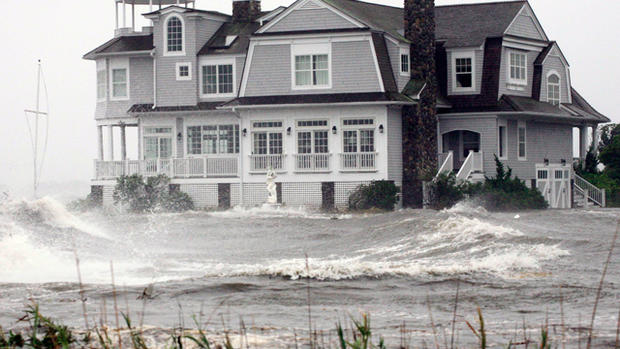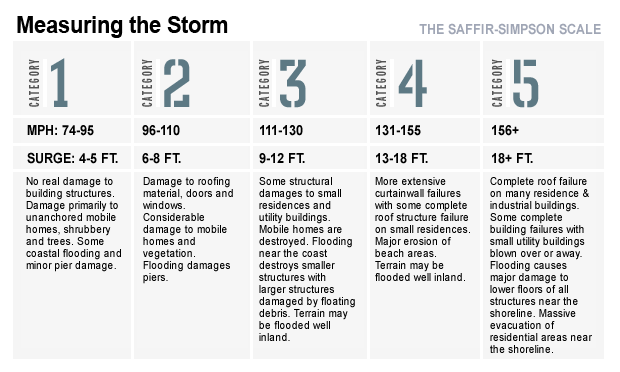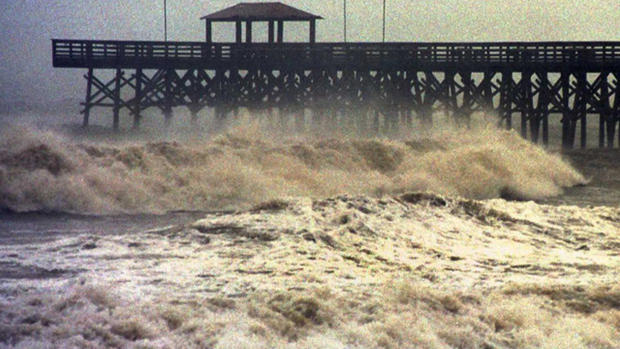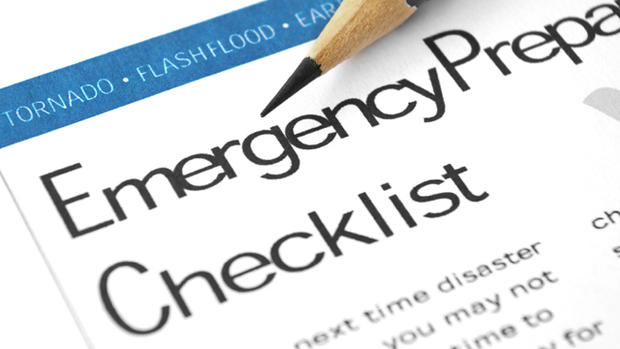Hurricane Irene punishes east coast of U.S.
Updated 2:15 a.m. ET
Hurricane Irene is drenching the mid-Atlantic states on its way to New England.
The National Hurricane Center says Hurricane Irene's sustained winds were topping out at 80 mph while the storm was moving north-northeast at a 17 mph clip. Irene will be moving over cooler waters but is still expected to stay a hurricane until landfall again near Long Island, N.Y., about midday Sunday.
Hurricane warnings extend north to Nantucket, Mass. A tropical storm warning extends all the way to the south coast of Nova Scotia, Canada.
The storm has knocked out power to at least 2 million customers from North Carolina to New Jersey.
Although it is weakening, the storm is still dangerous. Thus far, Irene has shut down New York and menaced other cities more accustomed to snowstorms than tropical storms as it steamed up the East Coast, unloading a foot of rain on North Carolina and Virginia.
New York emptied its streets and subways and waited with an eerie quiet. Washington braced for the onslaught, too, as did Philadelphia, the New Jersey shore and the Boston metropolitan area. Packing wind gusts of 115 mph, the hurricane had an enormous wingspan -- 500 miles -- and threatened a swath of the nation inhabited by 65 million people.
The hurricane stirred up seven-foot waves, and forecasters warned of storm-surge danger on the coasts of Virginia and Delaware, along the Jersey Shore and in New York Harbor and Long Island Sound. Across the Northeast, drenched by rain this summer, the ground is already saturated, raising the risk of flooding as well as the danger of trees falling onto homes and power lines.
As of 10:30 p.m. ET, the eye of the massive storm was about 35 miles northeast of Virginia Beach, Va., moving north-northeast at about 16 mph. Earlier, it had been moving at about 13 mph, but the storm passed back over warmer water, strengthening it.
CBS News meteorologist David Bernard reported earlier that Irene could gain strength again as it moves out over warmer Atlantic waters. It is expected to make a second landfall on Long Island sometime Sunday.
CBS News correspondent Bigad Shaban reports that officials in Ventnor, New Jersey, are worried about the storm surge that will follow Irene. The many who did not leave along the Jersey Shore could become trapped by the rising water.
Hurricane Irene live blogIrene made its official landfall just after first light near Cape Lookout, N.C., at the southern end of the Outer Banks, the ribbon of land that bows out into the Atlantic Ocean. Shorefront hotels and houses were lashed with waves. Two piers were destroyed, and at least one hospital was forced to run on generator power.
"Things are banging against the house," Leon Reasor said as he rode out the storm in the town of Buxton. "I hope it doesn't get worse, but I know it will. I just hate hurricanes."
By afternoon, the storm had weakened to sustained winds of 80 mph, down from 100 mph on Friday. That made it a Category 1, the least threatening on a 1-to-5 scale, and barely stronger than a tropical storm.
Hurricane Irene tracker
Irene: State-by-state look at dangers, prep
East Coast weathering Irene: Snapshots
After the Outer Banks, the storm strafed Virginia with rain and strong wind. It covered the Hampton Roads region, which is thick with inlets and rivers and floods easily, and chugged north toward Chesapeake Bay. Shaped like a massive inverted comma, the storm had a thick northern flank that covered all of Delaware, almost all of Maryland and the eastern half of Virginia.
The deaths blamed on Irene included two children, an 11-year-old boy in Virginia killed when a tree crashed through his roof and a North Carolina child who died in a crash at an intersection where traffic lights were out. Four other people were killed by falling trees or tree limbs - two in separate Virginia incidents, one in North Carolina and one in Maryland. A surfer and another beachgoer in Florida were killed in heavy waves.It was the first hurricane to make landfall in the continental United States since 2008, and came almost six years to the day after Katrina ravaged New Orleans. Experts guessed that no other hurricane in American history had threatened as many people.
At least 2.3 million were under orders to move to somewhere safer, although it was unclear how many obeyed or, in some cases, how they could.
Defense Secretary Leon Panetta told 6,500 troops from all branches of the military to get ready to pitch in on relief work, and President Barack Obama visited the Federal Emergency Management Agency's command center in Washington and offered moral support.
"It's going to be a long 72 hours," he said, "and obviously a lot of families are going to be affected."
In New York, authorities began the herculean job of bringing the city to a halt. The subway began shutting down at noon, the first time the system was closed because of a natural disaster. It was expected to take as long as eight hours for all the trains to complete their runs and be taken out of service.
On Wall Street, sandbags were placed around subway grates near the East River because of fear of flooding. Tarps were placed over other grates. Construction stopped throughout the city, and workers at the site of the World Trade Center dismantled a crane and secured equipment.
While there were plenty of cabs on the street, the city was far quieter than on an average Saturday. In some of the busiest parts of Manhattan, it was possible to cross a major avenue without looking, and the waters of New York Harbor, which might normally be churning from boat traffic, were quiet before the storm.
The biggest utility, Consolidated Edison, considered cutting off power to 6,500 customers in lower Manhattan because it would make the eventual repairs easier. Mayor Michael Bloomberg also warned New Yorkers that elevators in public housing would be shut down, and elevators in some high-rises would quit working so people don't get trapped if the power goes out.
"The time to leave is right now," Bloomberg said at an outdoor news conference at Coney Island, his shirt soaked from rain.
Video: The urban hurricane
Video: Hurricane wreaks havoc on travel
A day earlier, the city ordered evacuations for low-lying areas, including Battery Park City at the southern edge of Manhattan, Coney Island with its famous amusement park and the beachfront Rockaways in Queens.
The five main New York-area airports -- La Guardia, John F. Kennedy and Newark, plus two smaller ones -- waved in their last arriving flights around noon. The Giants and Jets postponed their preseason NFL game, the Mets postponed two baseball games, and Broadway theaters were dark.
New York has seen only a handful of hurricanes in the past 200 years. The Northeast is much more used to snowstorms -- including the blizzard last December, when Bloomberg was criticized for a slow response.
For all the concern, there were early signs that the storm might not be as bad as feared. Some forecasts had it making landfall as a Category 3 storm and perhaps reaching New York as a Category 2.
"Isabel got 10 inches from coming in the house, and this one ain't no Isabel," said Chuck Owen of Poquoson, Va., who has never abandoned his house to heed an evacuation order. He was referring to Hurricane Isabel, which chugged through in 2003.
Still, Owen put his pickup truck on a small pyramid of cinder blocks to protect it from the storm tide, which had already begun surging through the saltwater marshes that stand between Poquoson and Chesapeake Bay.
Airlines said 9,000 flights were canceled, including 3,000 on Saturday. Airlines declined to say how many passengers would be affected, but it could easily be millions because so many flights make connections on the East Coast. There were more than 10,000 cancellations during the blizzard last winter.
American Airlines spokeswoman Andrea Huguely said it was not clear when flights would resume out of New York.
"The one thing about a hurricane is that you can prepare for it and you just have to adapt your plan based on how the storm travels," she said. "It's basically an educated guessing game."
Greyhound suspended bus service between Richmond, Va., and Boston. Amtrak canceled trains in the Northeast for Sunday.
The power losses covered 900,000 homes and businesses and were heavily concentrated in Virginia and North Carolina. Dominion Resources reported almost 600,000 customers without power and Progress Energy 260,000, with much of the outages in Wilmington and Wrightsville Beach, N.C.
Irene roared across the Caribbean earlier this week, offering a devastating preview for the United States: power outages, dangerous floods and high winds that caused millions of dollars in damage.
Generators, batteries big sellers ahead of Irene FEMA: Chance of Katrina-like flooding at coast




